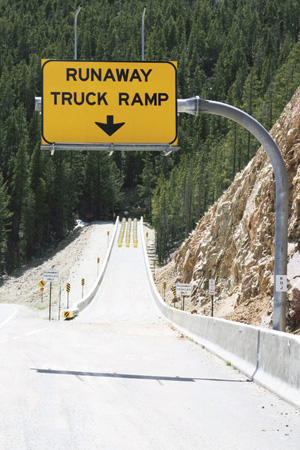Slow Your Roll: Proper Techniques for Braking on a Downgrade
A driver traveling in Nevada lost control of his truck going down a steep grade. He didn’t use the runaway ramp and propelled into a nearby house. The truck overturned and caught on fire, killing the driver on the scene.
Maintaining control of a truck while traveling downhill can be challenging, but it doesn’t have to be if you know how to properly brake and control your speed. While runaway ramps should be a last resort, you still need to be aware of what to expect in the event you have to use them.
 Study your route ahead of time and make note of any hilly or mountainous areas. Regardless of where you are, always be alert and watch for warning signs of approaching downgrades. Shift to a lower gear before you start down a hill. It can be very difficult to change gears while actually on a downgrade as the truck increases speed. The Commercial Driver License (CDL) manual lists the following factors to consider when maintaining a safe speed on a downgrade: your condition (i.e. fatigued, distracted), total weight of the vehicle and cargo, length and steepness of the grade, condition of the truck’s equipment, and road and weather conditions. Too many collisions are the result of drivers overestimating their equipment’s ability to maintain control.
Many drivers make the mistake of applying the brakes to reach the legal speed. Instead, you should use an alternating technique of braking down, building up, then braking down again. According to the CDL manual, brakes should be applied just hard enough to noticeably slow down. When you are slowed down to at least 5 mph below the posted legal/safe speed for trucks, release the brakes. When the speed increases again to the speed limit, brake down again.
This technique allows you to slow down without overusing the brakes but still keep the truck at the legal speed. Applying brakes to a speeding truck traveling downhill requires harder and longer brake applications which dramatically increase the opportunity for overheated and fading brakes. Engine retarders help slow down a truck while relieving regular brakes but you should not use them if the road is wet, icy or snowy. These and similar conditions can cause a truck’s drive wheels to slow down quicker than they have the traction to do, potentially causing the truck to lose control and jackknife.
Skid marks on the road are a sign that other drivers have had issues maintaining control in that area. You should proceed with caution and also be mindful of other truck drivers who appear to be losing control or moving toward a runaway ramp. Give these trucks as much room as possible to help them regain control and prevent a collision with them.
Runaway ramps should be considered a last resort. If you have to use a ramp, it means you have failed to properly prepare for the situation and did not do everything possible to prevent it. But if the brakes have failed or you have lost control, do not hesitate to use the ramps. Brakes can fail due to overheating or excessive use going down a grade. You will feel like you have no brakes even when the brakes are fully applied. At that point, runaway ramps are the only way the truck will be able to stop. It may be expensive to remove the truck from the ramp, but not using it can cost you and those you share the road with your lives.
Most runaway ramps are located off the right side of the road but all are preceded by warning signs of their location. Move into the correct lane before approaching downgrades, if possible. As you move onto the runaway ramp, steer straight and try to keep the wheels aligned. The ramps typically aren’t very wide and trucks run the risk of rolling over if they go over the edge of the ramp. Once you have stopped, call 911 to report the incident, even if you were not injured in the process.
There are several types of ramps, but they all essentially do the same thing. Take time to become familiar with runaway ramps, locations where they are most likely to exist, how to watch for them and what to do if you ever need to use them.
<< back |
